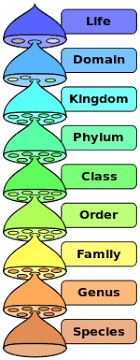|
|
| |
|
|
| |
|
|
|
|
| |
 |
| The basic scheme of
modern classification. Many other levels can be
used; domain, the highest level within life, is
both new and disputed. |
Taxonomy
Taxonomy is a branch of science. It is about the laws
and principles of classifying things. From one type of
taxonomy, many classifications might be produced.
The best-known kind of taxonomy is used for the
classification of lifeforms (living and extinct). Each
organism has a scientific name. This name is part of the
biological classification of that species. The name is
the same all over the world, so that when scientists
from different places talk or write about the living
thing, they can understand each other. In addition, a
species has a position in the tree of life. Thus the
crow is Corvus corone, a member of the Corvidae family,
and they are passerine birds. That is well agreed, but
the classification of other groups is not agreed at
present, and often several classifications are being
discussed.
Living things are classified into three domains:
bacteria, archaea and eukaryotes. The highest rank in a
domain is the kingdom. Each kingdom has many smaller
groups in it, called phyla. Each phylum has more smaller
groups in it, called classes. This pattern looks like
branches on a tree with smaller branches growing from
them. Each species is put into a group because of what
it does, how and what it eats, special body parts, and
so on. At the end of the pattern, the groups (genera)
are very small. Then each species in the genus is given
its own name.
When someone writes about a living thing and its formal
scientific name, they write the genus and species name.
This is known as binomial nomenclature, because it uses
two names for each organism. The first is the genus
name, and the second is the species in that genus. The
scientific name of the domestic cat is Felis catus.
Sometimes it is enough to write F. catus.
These are the major groups (ranks) used in taxonomy:
Kingdom --> Phylum --> Class --> Order --> Family -->
Genus --> Species
Some mnemonics (sayings to help a person remember
something): |
|
- King Phillip Came Over From Greater
Spain
|
When people started naming species, Latin was a language
widely used in Europe. All species names are still written
in Latin. This has some advantages. Since Latin is no longer
spoken, it is unchanging, and is owned by no-one. It gets
over the problem of every language having its own names for
animals and plants.
Scientists used to write the official description of each
new species in Latin. On 1 January 2012, the International
Botanical Congress changed to allow English (as well as
Latin) for describing new plant species. The International
Code of Zoological Nomenclature recommends choosing a
language that is widely used, and that is used in the places
where the species lives. |
|
Cladism
An important modern approach to taxonomy is cladism.
This approach is based on the branching (tree-like)
course of evolution. Like traditional Linnaean
classification, it uses traits to decide on the branches
of the classification. It insists on groups being
monophyletic. This has the effect that birds are not a
class but a sub-group of dinosaurs. It also means the
ranking system described above would be abolished.
So cladism has different principles of taxonomy, and
produces a different kind of taxonomy. Decisions, where
possible, are supported by DNA sequence analysis.
Present-day biological classification is a mixture of
the old Linnaean and the modern cladistic principles of
taxonomy. In parts, it is changing rapidly. The
classifications presented in Wikipedia at present are
often a compromise between the two systems. The details
are regularly discussed. |
|
Turmoil in taxonomy
Today, there are many changes in the classification of
living things. This turmoil in taxonomy has led to many
alternative classifications. It is caused partly from
the move from Linnaean to cladistic principles, and
partly by the use of DNA sequence data in taxonomy. An
example is: the way derived groups like birds should not
be classified at the same level as the group they
evolved from. Yet birds have traditionally been a class
under the Linnaean system.
The turmoil sometimes results in differences between
related pages. Pages may rely on different references
and different authors' opinions as to the present best
arrangement. |
|
 Kiddle: Taxonomy Kiddle: Taxonomy
Wikipedia: Taxonomy |
|
|
|
|
|
|
|
|
|
|
|
|
|
|
|
|
Search Fun Easy English |
|
|
|
|
|
|
|
|
|
|
|
|
|
|
|
About
Contact
Copyright
Resources
Site Map |